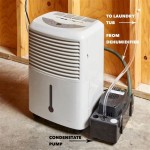How to Seal Concrete Basement Walls: A Comprehensive Guide
Protecting your basement walls from water damage is crucial for maintaining a dry, comfortable living space. Concrete basement walls, while durable, are porous and can allow moisture to seep through, leading to mold, mildew, and foundation problems. Sealing your concrete basement walls is an effective way to prevent these issues and ensure the longevity of your basement.
Step 1: Prepare the Walls
Before applying any sealant, it is essential to prepare the basement walls properly. Start by removing any dirt, dust, or debris from the walls using a broom or vacuum cleaner. Then, check for any cracks or holes in the walls and repair them using hydraulic cement or epoxy patching compound.
Step 2: Choose the Right Sealant
There are various types of sealants available for concrete basement walls, including latex-based, epoxy-based, and urethane-based sealants. Consider the specific needs of your basement when selecting a sealant. For instance, epoxy-based sealants offer excellent resistance to water and chemicals, while urethane-based sealants are more flexible and can accommodate movement in the walls.
Step 3: Apply the Sealant
Once you have chosen a sealant, follow the manufacturer's instructions for application. Typically, applying the sealant involves using a paint roller or brush to apply an even layer to the walls. Allow the first coat to dry completely before applying a second coat for optimal protection.
Step 4: Install Vapor Barrier
After sealing the walls, installing a vapor barrier is recommended to prevent moisture from penetrating the walls from the ground. Plastic sheeting or house wrap can be used as a vapor barrier. Staple or tape the vapor barrier to the walls, overlapping the edges for maximum effectiveness.
Step 5: Consider Drain Tile and Sump Pump
If your basement is prone to water seepage from the ground, installing drain tile and a sump pump can be beneficial. Drain tile collects water and directs it to the sump pump, which then pumps the water away from the house.
Step 6: Monitor and Maintain
Once your basement walls are sealed, it is crucial to monitor them regularly for any signs of water damage. Inspect the walls for cracks, moisture spots, or mold growth. If any issues are found, address them promptly to prevent further damage.
Additional Tips
- Allow ample time for the sealant and vapor barrier to dry before using the basement.
- Use a dehumidifier in the basement to control moisture levels.
- Keep gutters and downspouts clean and in good condition to prevent water from pooling around the foundation.
- Grade the soil around the house so that it slopes away from the foundation, directing water away from the basement walls.
- Consider seeking professional help from a waterproofing contractor if you have persistent water problems in your basement.

Waterproofing Basement Walls Dos And Don Ts To Remember Bob Vila

How To Waterproof Basement Walls With Flex Seal Products Youtube

How To Seal A Basement Wall From Moisture And Water Seepage Youtube

Waterproofing Basement Walls Dos And Don Ts To Remember Bob Vila

How To Waterproof Your Basement True Value

How To Waterproof Basement Walls From Inside Sani Tred

Diy Basement Waterproofing Sealonce System Easy Installation Waterproof Com

How To Insulate A Basement Wall Greenbuildingadvisor

How To Fix Basement Wall Cracks American Dry

How To Waterproof A Basement Easy Video Installation Guide Sealonce System Com
See Also








